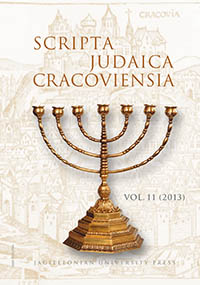What Does Tel Shalem Have To Do with the Bar Kokhba Revolt?
What Does Tel Shalem Have To Do with the Bar Kokhba Revolt?
Author(s): Menahem MorSubject(s): Jewish studies
Published by: Wydawnictwo Uniwersytetu Jagiellońskiego
Keywords: Tel Shalem; Bar Kokhba Revolt; Galilee; Beth Shean; Caesarea; Petra; Dura Europos; Hadrian; Tineius Rufus; legio X Fretensis; legio VI Ferrata
Summary/Abstract: In the research on the Bar Kokhba revolt (132-136 CE); one of the central subjects that were given prominent attention was the territorial extent of the second revolt. During all the years of research on this geographical question, two schools of thought were formed. One of them is that of the maximalists, who claim that the revolt spread through the entire Provincia Judaea and even beyond it into neighboring provinces such as Provincia Arabia in the south and Provincia Syria in the north. The second one is that of the minimalists, who restrict the revolt to the area of the Judaean hills and their immediate environs. The role of the Galilee region in the second revolt was discussed in great depth and centered on the question of whether the Galilee had taken part in the revolt. Since 1999, Professor Werner Eck of the University of Cologne focused on the power and range of this revolt from the Roman perspective. His general conclusion was that the second revolt was a central event in the history of the Roman Empire. Large military units participated in the event, which spread all over the province and even beyond. The rebels caused the Romans enormous casualties. They were forced to subdue the revolt savagely, causing the rebels massive losses. The revolt had a strong influence on the Roman Empire, and caused heavy damage to the Roman army that had immediate effects as well as long-term implications. His conclusions were based on a study of a variety of subjects including the archaeological discoveries from Tel Shalem, situated in the Beth Shean Valley, two kilometers south of Kibbutz Tirat Zvi and about 12 kilometers south of Scythopolis. The finds consisted of parts of a bronze statue and a head that was identified as that of the Roman emperor Hadrian, and a monumental inscription which had been inscribed in three lines on an arch that was 11 meters wide. According to W. Eck, these findings testify to the participation of the north, the Jordan Valley and the Galilee in the Second Revolt; and that the “Galilee felt the revolt more than has hitherto been conceded. A decisive battle may have been won here, not far from Caparcotna, the camp of the Second Legion in Judaea” (Eck 1999). This paper will re-examine the evidence from Tel Shalem, and other places in Galilee, mainly the findings from Kh. El-hamam in eastern Galilee, findings that were used to include the Galilee Region in the geographical expansion of the revolt. We will study anew the historical background for the erection of the Tel Shalem inscription, the various epigraphic interpretations, and other evidence and its implications for the study of the revolt. Our study will question some of the broadening assumptions of the revolt, and will leave out Galilee in general, and Tel Shalem in particular, from the geographical scope of the Bar Kokhba Revolt.
Journal: Scripta Judaica Cracoviensia
- Issue Year: 2013
- Issue No: 11
- Page Range: 79–96
- Page Count: 18
- Language: English

